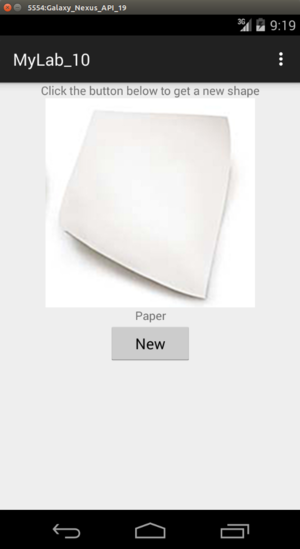Difference between revisions of "CISC181 F2017 Lab7"
From class_wiki
(Created page with "==Preliminaries== * Make a new project with ''n'' = 7 (following these instructions) * Name your main class "Lab7" (when creat...") |
|||
| (One intermediate revision by the same user not shown) | |||
| Line 1: | Line 1: | ||
| − | ==Preliminaries== | + | ===Preliminaries=== |
| + | * Make a new '''Android''' project with ''n'' = 7 following [[CISC181_F2017_NewAndroidStudioProject | these ]] instructions through step 6. On step 7 "Select form factor...", switch over to step 4 on the Android developers page tutorial [https://developer.android.com/training/basics/firstapp/creating-project.html here] and complete through step 6 which ends with "...click '''Finish'''". Make the activity be called "MyActivity". | ||
| − | + | ===Instructions=== | |
| − | |||
| − | + | First, make the empty activity project as described above and confirm that you can build and run it -- either on the emulator or an actual Android device as explained on the next page [https://developer.android.com/training/basics/firstapp/running-app.html "Run Your App"]. | |
| − | + | Second, take the empty activity project and modify it to become a very simple "rock paper scissors" generator as detailed below: | |
| − | + | # Change the layout in <tt>activity_my.xml</tt> to a vertical <tt>LinearLayout</tt>, similar to [http://developer.android.com/guide/topics/ui/layout/linear.html this example] | |
| + | # Change the old <tt>TextView</tt> that was printing "Hello, world" to say "Click the button below to get a new shape". | ||
| + | # Add an <tt>ImageView</tt> underneath, centered laterally, that initially shows a rock, paper, OR scissors image. Find your own for these, cropped and scaled to 250 x 250, and put them in <tt>res/drawable</tt> with the names "rock.png", "paper.png", and "scissors.png". Here's some help for [http://developer.android.com/guide/topics/resources/drawable-resource.html drawable resources] | ||
| + | # Add a <tt>TextView</tt> underneath the image which acts as a caption, saying "Rock" if the image is a rock, "Paper" if it's paper, and "Scissors" if it's scissors. The caption should be centered laterally. | ||
| + | # Finally, add a centered <tt>Button</tt> under the caption. This button should be labeled "New" and when pressed causes another random selection which (possibly) changes the image and caption above . The caption text should be set not through resources but instead by using <tt>setText()</tt> in <tt>MyActivity.java</tt>, and something similar should be done with the image. | ||
| − | + | ''Note'': Do NOT make changes to any other XML resource file besides <tt>activity_my.xml</tt>. | |
| − | + | Here is a screenshot of a sample program that satisfies the above requirements (except it should say "MyLab_7"): | |
| − | |||
| − | |||
| − | + | [[Image:300px-Lab10.png]]<br> | |
| − | |||
| − | |||
| − | |||
| − | |||
| − | |||
| − | ==== | + | ===Submission=== |
| − | |||
| − | |||
| − | + | Submit your <tt>MyActivity.java</tt> and <tt>activity_my.xml</tt>. Make sure your name is in both. FYI, comments in XML files look like this: | |
| − | < | + | <nowiki> |
| − | + | <!-- here is my name --> | |
| − | + | </nowiki> | |
| − | |||
| − | |||
| − | |||
| − | |||
| − | |||
| − | |||
| − | |||
| − | |||
| − | |||
| − | |||
| − | |||
| − | |||
| − | |||
| − | |||
| − | |||
| − | |||
Latest revision as of 08:54, 7 November 2017
Preliminaries
- Make a new Android project with n = 7 following these instructions through step 6. On step 7 "Select form factor...", switch over to step 4 on the Android developers page tutorial here and complete through step 6 which ends with "...click Finish". Make the activity be called "MyActivity".
Instructions
First, make the empty activity project as described above and confirm that you can build and run it -- either on the emulator or an actual Android device as explained on the next page "Run Your App".
Second, take the empty activity project and modify it to become a very simple "rock paper scissors" generator as detailed below:
- Change the layout in activity_my.xml to a vertical LinearLayout, similar to this example
- Change the old TextView that was printing "Hello, world" to say "Click the button below to get a new shape".
- Add an ImageView underneath, centered laterally, that initially shows a rock, paper, OR scissors image. Find your own for these, cropped and scaled to 250 x 250, and put them in res/drawable with the names "rock.png", "paper.png", and "scissors.png". Here's some help for drawable resources
- Add a TextView underneath the image which acts as a caption, saying "Rock" if the image is a rock, "Paper" if it's paper, and "Scissors" if it's scissors. The caption should be centered laterally.
- Finally, add a centered Button under the caption. This button should be labeled "New" and when pressed causes another random selection which (possibly) changes the image and caption above . The caption text should be set not through resources but instead by using setText() in MyActivity.java, and something similar should be done with the image.
Note: Do NOT make changes to any other XML resource file besides activity_my.xml.
Here is a screenshot of a sample program that satisfies the above requirements (except it should say "MyLab_7"):
Submission
Submit your MyActivity.java and activity_my.xml. Make sure your name is in both. FYI, comments in XML files look like this:
<!-- here is my name -->
